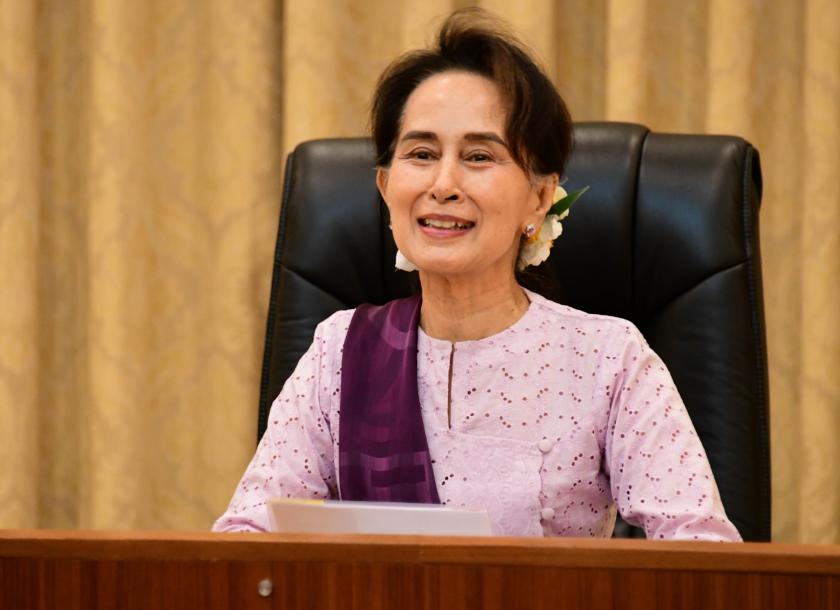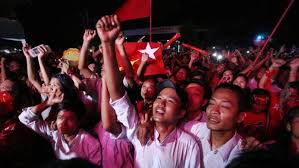From Darling of the West to Pariah and Back Again?
In October 2016 a military crackdown in Rakhine State, Myanmar (or Burma as it is commonly known), began a large-scale persecution of the Rohingya people, claimed by many as a genocide. There were widespread reports of ethnic cleansing, extra-judicial killings, summary executions, mass out-migration into Bangladesh which created the biggest refugee camp in the world, gang rapes and infanticide.
The surprising factor in all of this was not just that the violence was committed by a Buddhist state against a Muslim minority, but that the leader of Myanmar was Aung San Suu Kyi: Nobel Peace Prize winner, human rights darling of the west, leader of democratisation in Myanmar.
Who is Aung San Suu Kyi?

You could argue that Aung San Suu Kyi was born to be the first democratic leader of Myanmar.
Her father was Bogyote Aung San, father of modern-day Myanmar and leading anti-colonialist fighting against British rule. He founded the Myanmar Armed Forces as well as the Communist Party of Burma, the oldest political party in Myanmar. When Japan invaded he worked in the Japanese military, then when the tide turned switched sides and in 1946 became the Premier of the British Crown Colony of Burma. He made an agreement with the British Prime Minister Clement Atlee that gave Burma it’s independence, and his Anti-Fascist People’s Freedom League won the first election in 1947.
Before the election though, Aung San was assassinated in a plan hatched by a former colonial era prime minister, U Saw, who was hanged for his crime. Conspiracies remain however, that it was British intelligence, fearing the prospect of a united front government with communist forces, or that it was members of the Burmese military.
Going off on a tangent somewhat, Aung San’s remains were placed in a newly built Martyr’s Cemetery at the Shwedagon Pagoda in Yangon. His mausoleum was destroyed in 1983 when North Korean agents attempted but failed to assassinate the South Korean President Chun Doo-hwan with explosives. The mausoleum was later rebuilt.
Aung San Suu Kyi was thus born in British Burma, and was two years old when her father was killed and three years old when it was granted independence. She was educated at the University of Delhi, her widowed mother having been appointed Burmese Ambassador to India, and then the University of Oxford, where she gained a degree in philosophy, politics and economics, as do many in the British ruling class.
Aung San Suu Kyi worked for the United Nations in New York for three years, then married a British historian, Michael Aris, who specialised in Himalayan studies and settled in North London.
Up until now, Aung San Suu Kyi had lived the colonial ideal, but in 1988 decided to return to Burma to care for her aging mother. That year though saw huge demonstrations against military rule, and Aung San Suu Kyi quickly became a leader of the movement, addressing crowds of hundreds of thousands of people. The demonstrations started on the 8th of August 1988, becoming known as the 8888 Uprising.
Aung San Suu Kyi founded the National League for Democracy, based on principles of not just democracy but Buddhism and non-violence, having been profoundly influenced by Gandhi’s politics in India.
Unsurprisingly, she was placed under house arrest in 1989. The government allowed her to leave the country as long as she never returned, but she refused and remained under arrest. In 1990 the NLD won the elections, only for the military rulers to nullify the results. Aung San Suu Kyi was awarded the Nobel Peace Prize for her work towards the democratisation of Myanmar with its emphasis on human rights and non-violence.
During this time visiting Myanmar as a tourist was notoriously difficult.
To cut a long story short, Aung San Suu Kyi spent 15 years over the next few decades in house arrest and became one of the leading global names of the champions of human rights and democratisation. She was released in 2010, won various elections without the military allowing national control, and eventually in 2015 swept the elections, becoming the State Counsellor and de facto face of the Myanmar government.
Was Myanmar a Democracy?

Up to now, you could argue that Aung San Suu Kyi’s story was almost Disney-esque, and she was a champion of democracy and human rights revered in her own country and also by national elites in the US and throughout the West.
However, this is not how it panned out.
Myanmar is a nation of hundreds of ethnic groups, with numerous languages and a population of 54 million. The main religion is Buddhism and the main language is Burmese. The main city is Yangon, formerly known as Rangoon, but the capital city is now Naypyitaw.
To read about the coup in Burma click here.
Ethnic conflicts in Shan and Kachin states had led to thousands of refugees fleeing across the border with China. However, the main problem was with the Rohingya. With a population of over 1 million in Burma, this predominantly Muslim ethnic group was attacked by the Myanmar military
Aung San Suu Kyi refused to grant citizenship to the Rohingya, and hundreds of thousands fled the country. This was ethnic cleansing at its finest, and led by the face of democracy and human rights, Nobel Prize winning, darling of the West, Aung San Suu Kyi.
She justified her stance as one of non-interference, claiming that both sides in the conflict had committed violence. She was criticised by human rights groups and some called for her Nobel Prize to be revoked. Even the Dalai Lama got on the phone to encourage her to change her actions. She was broadly seen as, if not encouraging it, legitimising genocide. She had awards revoked from Oxford City Council and also the United States Holocaust Memorial Museum. Bob Geldof returned his Freedom of the City of Dublin award, claiming not to want an award also given to Aung San Suu Kyi.
The main thing we can probably take from all this is the complete madness of the people in the Western-led democratisation and human rights circles, disturbed as they were that Disney stories don’t reflect reality all that much after all.
So what is happening in Myanmar?
On the 1st of February this year, after elections which returned Aung San Suu Kyi’s NLD with a huge minority, the military carried out a coup and placed her back under arrest. Needless to say, no solution to the Rohingya problem had been found in the meantime.
Min Aung Hlaing, commander-in-chief of the Myanmar Military, took power, and light was shed on the process of democratisation seeming to have been taking place since 2011.
In fact, this democratisation was never near completion. The constitution was still approved by the military and political parties like the NLD had to gain huge minorities to officially take power. But even with them in power, the military retained significant control over all aspects of Myanmar politics and economics.
Myanmar had been under heavy international sanctions while under military rule, but with the allowing of elections and the coming to power of the NLD sanctions were swiftly lifted by the USA and generous aid was given by western countries. However, the power structures had hardly changed, except on the face of it, and the US lifting of sanctions and gift of aid can be seen as an exercise in reward when none was yet due.
In fact, the US actions were criticised as encouraging the military to retain in control and to see democratisation as an event, represented by an election and a new government, rather than a potential decades-long process.
How will this story end?
It is easy to make various criticisms of the situation we have described thus far. Firstly, the human rights and democratisation paradigm sees heroes and villains, avoids black and white, and is basically childish in its analyses, latching onto “causes” but failing to understand realities.
Is it really so far-fetched to think a child of British colonialism and its elite education system could hold Islamophobic or anti-ethnic minority views? Furthermore, Buddhism is commonly thought of as the religion of peace and harmony, but where state power is concerned how far-fetched is it to imagine that Buddhism can become a religion of repression and violence? Maybe we could ask the Japanese about that one.
As I write, crowds are still protesting on the streets of Burma, against the military coup and for the release of ‘Aunty’ Aung San. But the prospect of actual democratisation and the relinquishing of control by the military remains as far away as ever; the mirage of democracy in Burma is just that.
The prospect of Aung San Suu Kyi herself regaining the image she once enjoyed in the west is likely equally remote.
In this increasingly bipolar world, the main question might be whether the military government builds closer ties with China or tries to remain “neutral”. When the coup was brought up in the United Nations Security Council, official UN condemnation was vetoed by China.
Lastly, in our pandemic-fuelled and divided worlds, where social media battles increasingly replace any sort of meaningful discussion and struggle, and we are all simply automatons of big-tech, the video of the coup captured accidentally by a local woman’s morning aerobics session certainly went some way to symbolising the madness.
